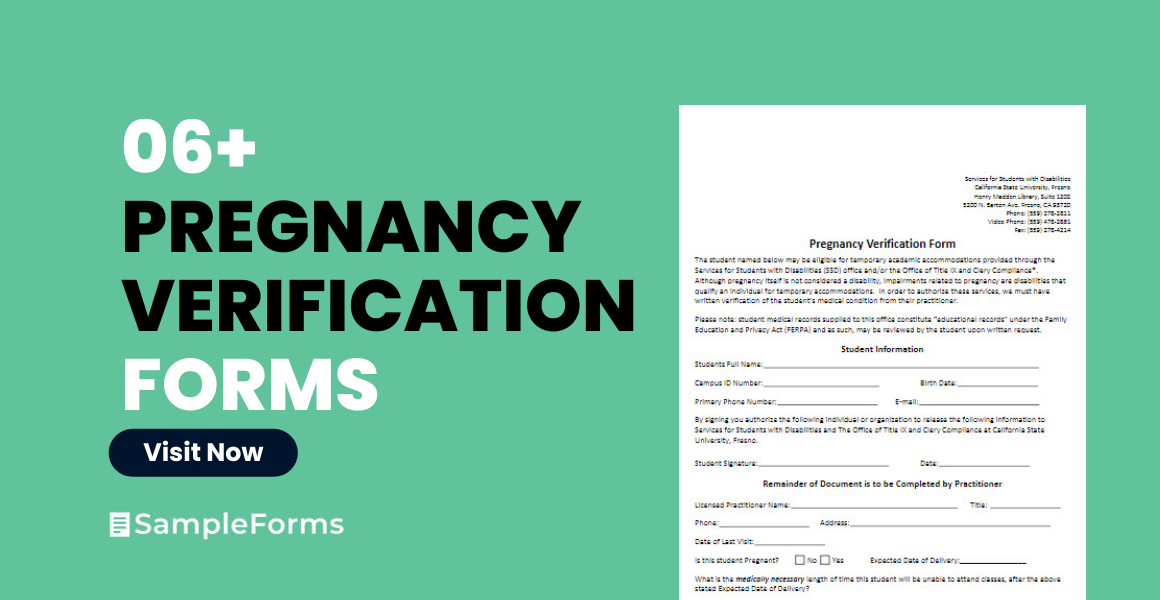Embarking on the exciting voyage of motherhood begins with a cascade of emotions and a plethora of paperwork. A Pregnancy Verification Form acts as an essential key, unlocking the gates to a variety of benefits and services tailored for expecting mothers. Within this guide, immerse yourself in the profound depths of its meaning, diverse types, and vivid examples. Together, we’ll explore crafting this pivotal document, ensuring you are adeptly navigating through the serene waters of maternity administrative necessities.
What is a Pregnancy Verification Form? – Definition
A Pregnancy Verification Form is an official document that confirms and validates the status of a woman’s pregnancy, typically signed by a qualified healthcare professional, such as a doctor or a midwife. These printable form provides essential information such as the estimated due date, the duration of the pregnancy, and occasionally, additional health data pertinent to prenatal care and administrative use. Often utilized for purposes such as informing employers, applying for maternity leave, obtaining medical services, or securing various benefits, it acts as a recognized attestation of pregnancy in various contexts and processes.
What is the Meaning of the Pregnancy Verification Form?
The meaning of a Pregnancy Verification Form transcends its apparent functionality of confirming a pregnancy. This document serves as a pivotal affirmation, attesting to the commencement of a significant life event – pregnancy. It facilitates the alignment of medical, legal, and occupational elements with the new development in an individual’s life. Providing not just a confirmation, it often encapsulates key details like gestational age, expected due date, and sometimes, preliminary health assessments form. The form ultimately symbolizes a bridge connecting the personal, joyful anticipations of a growing family to the practical, administrative world, ensuring that the individual can access pertinent services, rights, and care associated with pregnancy and childbirth.
What is the Best Sample Pregnancy Verification Form?
A sample Pregnancy Verification Form must encompass several vital details to ensure it’s thorough and serves its purpose effectively across various contexts like healthcare, employment, and insurance. Below is a detailed breakdown of a comprehensive form, keeping in mind that actual forms might slightly differ depending on the institution or legal jurisdiction:
Header Information:
- Title: Clearly labeled as “Pregnancy Verification Form” to ensure clarity of purpose.
- Institution Details: Name, address, and contact information of the healthcare provider or institution issuing the form.
- Patient Details: Full name, date of birth, address, and contact information of the pregnant individual.
Pregnancy Details:
- Confirmation: A statement confirming the pregnancy.
- Estimated Due Date (EDD): The anticipated date of delivery.
- Gestation Age: The current stage of pregnancy, often stated in weeks.
- Pregnancy Risks: If applicable, a brief note on any identified risks or concerns related to the pregnancy.
Healthcare Provider’s Details:
- Name: Full name of the healthcare professional confirming the pregnancy.
- Qualification: Professional qualifications or certifications.
- Signature: Signature of the healthcare professional.
- Date: The date when the form was filled and signed.
Disclaimer/Notes Section:
- Confidentiality Statement: A reminder that the details within the form are confidential and should be treated with privacy and discretion.
- Additional Notes: Space for any additional notes or comments pertinent to the pregnancy or patient.
Guidelines/Instructions for Submitting:
- Submission Details: Where and how the form should be submitted (if applicable).
- Deadline: Any pertinent deadlines for submitting the form for specific purposes.
Optional Sections:
- Previous Pregnancy History: Sometimes included to offer additional insight into the patient’s medical history.
- Early Pregnancy Assessment: Brief details of any assessments, tests, or ultrasound findings.
Best Practices for a Sample Form:
- Clarity: Ensure all sections are clear, straightforward, and easy to understand.
- Privacy Compliance: Ensure the form adheres to relevant privacy laws and policies like HIPAA in the USA.
- Accessibility: Ensure it is easily accessible and can be understood by individuals from various backgrounds.
- Legality: Ensure all information requested and provided adheres to legal and ethical guidelines relevant to the jurisdiction.
This sample outline for a Pregnancy Verification Form ensures comprehensiveness and precision, guaranteeing it is insightful for healthcare providers, while also offering clear, concise, and crucial information for administrative or legal processes. Always consider checking with local guidelines or a legal advisor to ensure all information is compliant with current regulations and laws. You should also take a look at our Proof of Pregnancy Form
FREE 6+ Pregnancy Verification Forms
1. Pregnancy Verification Form
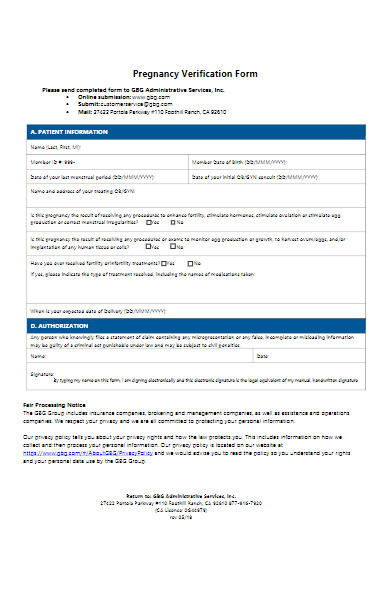
2. Pregnancy Verification Letter Form
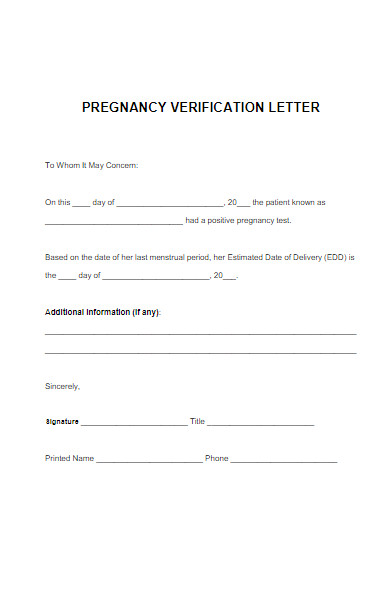
3. Pregnancy Confirmation Form
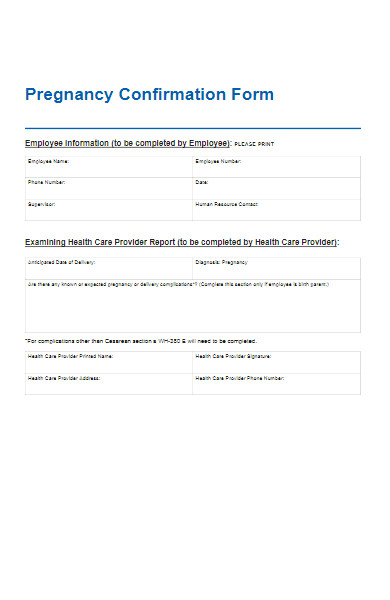
4. Sample Pregnancy Verification Form
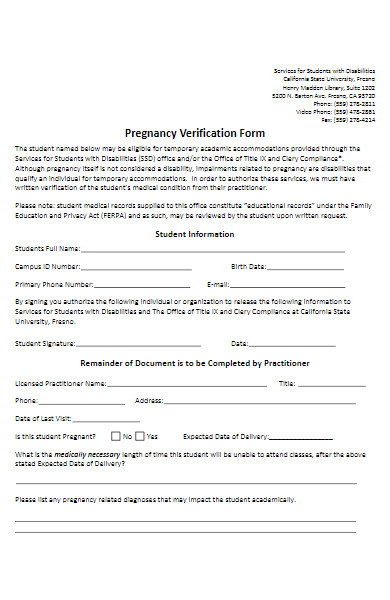
5. Verification of Pregnancy Form

6. Pregnancy Verification for Home Out Births Form
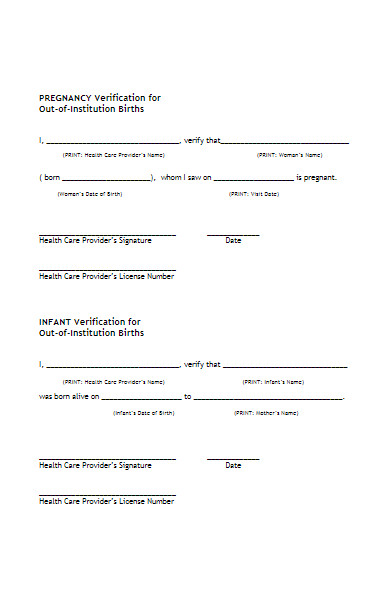
7. Radiology Pregnancy Verification Form
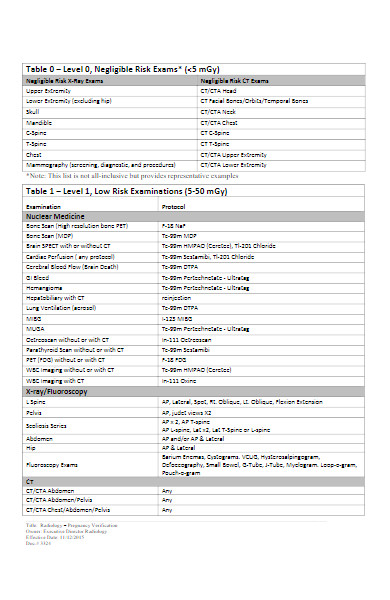
When is the right time to fill out a Pregnancy Verification Form?
Navigating through the various administrative aspects of pregnancy, the timely completion of a Pregnancy Verification Form emerges as a crucial step. Generally, the right time to fill out this form is as soon as a healthcare professional has confirmed the pregnancy, to facilitate several pivotal proceedings:
For Healthcare:
- To establish a proper prenatal care schedule and facilitate any necessary early interventions.
- To properly document the pregnancy in medical records for upcoming appointments and assessments.
For Employment:
- To inform employers and initiate dialogues related to maternity leave and any potential workplace accommodations.
- To ensure that any workplace rights related to pregnancy are upheld and facilitated as early as possible.
For Legal and Administrative Purposes:
- To access social services, support programs, or benefits that become applicable with a verified pregnancy.
- To initiate processes for maternity coverage and related aspects in health insurance.
For Personal Readiness:
- To facilitate discussions with family and close ones, ensuring mental, emotional, and logistical preparedness for the upcoming change.
Considerations:
- Verification Accuracy: Ensure that the pregnancy is accurately verified and relevant details like the estimated due date are precisely determined.
- Provider Guidelines: Adhere to guidelines or timelines suggested by healthcare providers or relevant administrative bodies for form submission.
- Legal and Policy Requirements: Be mindful of any legal or policy deadlines for submitting pregnancy verification to employers, insurance entities, or other relevant bodies.
- Confidentiality: Ensure that the process respects your privacy and share the confirmation as per your comfort and requirement.
In essence, the right time to fill out a Pregnancy Verification Form may vary based on individual circumstances, healthcare timelines, and specific administrative or legal requirements. It is often prudent to complete and utilize the form as soon as it’s needed to access relevant support, care, and accommodations during the pregnancy. Always consult with your healthcare provider and refer to specific guidelines related to your employment, insurance, and local laws to ensure optimal timing. Our maternity allowance form is also worth a look at
Why do I need a Pregnancy Verification Form?
A Pregnancy Verification Form, while seemingly a simple document, performs an array of crucial roles across various facets of an individual’s pregnancy journey. Here are the pivotal reasons why obtaining a Pregnancy Verification Form is indispensable:
1. Legal and Administrative Utilization:
- Employment: To inform employers officially about your pregnancy, ensuring rightful access to maternity benefits and necessitating workplace adjustments.
- Legal Proceedings: To provide a credible proof of pregnancy in legal scenarios where verification of pregnancy status may be requisite.
2. Accessing Benefits and Supports:
- Government Benefits: To apply for and avail government-sponsored maternity benefits and programs.
- Insurance Purposes: To authenticate pregnancy claims with insurance providers, securing financial and medical support.
3. Medical and Healthcare Coordination:
- Prenatal Care: To establish and maintain a coherent and tailored prenatal care plan with healthcare providers.
- Medical Records: To update your healthcare records, ensuring consistency and accuracy in your medical data.
4. Academic or Educational Implications:
- Accommodations: To request and obtain necessary academic accommodations, such as modified schedules or assignment extensions.
- Leave: To apply for relevant leave of absence or adjustments in an educational setting.
5. Emotional and Psychological Aspect:
- Validation: While mainly a practical document, having a formal verification can also serve as a tangible affirmation of this new life chapter.
- Community Support: In some contexts, providing verification might facilitate access to community and social support systems during pregnancy.
6. Ethical and Respectful Disclosure:
- Privacy: Allows you to disclose your pregnancy in formal settings in a confidential and respected manner.
- Control: Having a form enables you to choose when and how to disclose your pregnancy in various official or personal contexts.
7. Ensuring Safety and Well-being:
- Workplace Safety: Facilitates necessary adjustments or reassignments in the workplace to ensure a safe environment.
- Health Advocacy: Acts as a tool to advocate for your health and well-being in various scenarios, ensuring you and your baby’s safety are prioritized.
8. Future Reference:
- Documentation: Serves as a formal document that can be referred to or utilized in future circumstances.
- Record Keeping: Helpful for maintaining organized and documented records of significant life events.
In essence, a Pregnancy Verification Form intertwines with various aspects of life, acting as a key enabler in safeguarding rights, accessing support, and ensuring a secure and supportive environment throughout the pregnancy journey. Its utility spans across medical, legal, and personal realms, ensuring the well-being of both the individual and the upcoming new addition to the family.
Who is authorized to sign a Pregnancy Verification Form?
A Pregnancy Verification Form is a critical document that demands authenticity and accuracy due to its legal and administrative implications. Consequently, only authorized healthcare professionals who have the legitimate capacity to confirm and validate a pregnancy are typically permitted to sign this fillable form. Below are the general entities who are commonly authorized:
1. Licensed Physicians:
- General Practitioners: Doctors who have verified the pregnancy through accepted medical procedures.
- Obstetricians: Specialists in pregnancy and childbirth.
2. Certified Midwives:
- Certified Nurse-Midwives (CNM): Registered nurses who have additional training and certification in midwifery.
- Certified Professional Midwives (CPM): Professionals certified in midwifery, focusing particularly on pregnancy, childbirth, and postpartum period.
3. Nurse Practitioners:
- Family Nurse Practitioners (FNP): Registered nurses with advanced training, often authorized to provide pregnancy verification.
- Women’s Health Nurse Practitioners (WHNP): Specializing in women’s health, including pregnancy.
4. Other Healthcare Professionals:
- Physician Assistants: In some jurisdictions, physician assistants might be authorized to verify pregnancy and sign the form.
- Specialist Doctors: Such as endocrinologists or fertility specialists who might be involved in confirming pregnancy.
5. Medical Officers:
- Government Medical Officers: In certain contexts or programs, medical officers of specified government health departments might be authorized.
- Military Medical Officers: For individuals in the military, an appointed medical officer might be the designated authority.
Legal and Regional Considerations:
- Legislation: The authorization might depend significantly on local, state, or country-specific legislation regarding healthcare practice.
- Institutional Policy: Different institutions (like hospitals or clinics) may have their own policies dictating who is authorized.
- Medical Boards: Some regions may require the professional to be registered with a recognized medical board.
Final Considerations:
- Verification Accuracy: The professional signing should ensure that all information is accurate and obtained through reliable testing and examination.
- Ethical Consideration: Ethical principles should be adhered to, ensuring privacy, accuracy, and sincerity in verification.
- Documentation: Ensure all relevant details of the professional (like name, qualifications, and license number) are documented on the form for reference and accountability.
In essence, the authorized entity often intertwines with legal stipulations, professional ethics, and institutional policies. It is paramount that the signatory has the valid credentials, adheres to ethical norms, and ensures utmost accuracy and sincerity in providing verification, considering the vital implications this document carries in various aspects of the individual’s pregnancy journey. Always check local and institutional guidelines to ascertain specific authorized entities. In addition, you should review our Medical clearance forms.
How do I obtain a Pregnancy Verification Form?
Obtaining a Pregnancy Verification Form involves a blend of administrative and medical steps, ensuring that you secure a document that is both accurate and officially recognized. Here’s a general guide to acquiring a Pregnancy Verification Form:
Step 1: Confirming the Pregnancy
- Medical Appointment: Schedule a visit with a qualified healthcare provider (HCP) like an obstetrician, midwife, or general practitioner.
- Pregnancy Test: Undergo a professional pregnancy test and, if available, an ultrasound to validate and understand the status and progress of the pregnancy.
Step 2: Requesting the Form
- Direct Request: After the confirmation, explicitly request your HCP for a Pregnancy Verification Form.
- Legal or Official Needs: Explain any specific requirements or details that need to be included on the form for legal or administrative purposes.
Step 3: Filling the Form
- HCP Details: Ensure the healthcare provider includes their name, signature, credentials, and date on the form.
- Pregnancy Details: Make sure the form contains accurate details about the pregnancy, like the estimated due date and gestational age.
Step 4: Understanding and Verifying the Information
- Accurate Details: Verify all the information provided on the form for accuracy and completeness.
- Understanding Entries: Ensure that you comprehend all entries and details to accurately relay or utilize the information when needed.
Step 5: Utilizing and Storing the Form
- Official Use: Employ the form wherever necessary, such as at your workplace, insurance office, or educational institution.
- Safe Storage: Keep the original form in a secure location and consider making copies for usage in various capacities.
Step 6: Legal and Administrative Applications
- Legal Use: Provide the form in scenarios where legal verification of pregnancy is needed.
- Administrative Usage: Use the form to apply for relevant benefits, leaves, or accommodations.
Additional Tips:
- Digital Copies: Consider storing a digital copy securely, ensuring accessibility when needed.
- Understand Policy: Familiarize yourself with policies related to maternity at your workplace or institution to leverage the benefits effectively.
- Community Resources: Explore community resources or forums to understand where and how the form might need to be utilized.
- Multiple Copies: If dealing with multiple entities (like employers, schools, etc.), you might need additional signed copies of the form.
Alternative Options:
- Health Departments: In certain cases, local health departments or government bodies may also provide pregnancy verification forms upon receiving medical confirmation.
- Online Platforms: Some healthcare providers may offer online platforms where digital verification forms can be requested and downloaded securely.
Remember that the specifics of obtaining, filling, and utilizing a Pregnancy Verification Form might vary depending on your geographical location, healthcare provider, and specific personal, legal, or employment circumstances. Always consult with your healthcare provider and possibly a legal advisor to ensure accurate and optimized utilization of the intake form.
What information is required on a Pregnancy Verification Form?
A Pregnancy Verification Form serves as a crucial document, verifying and confirming an individual’s pregnancy in a formal and recognized manner. It must contain precise and authentic information that not only validates the pregnancy but also can be utilized in various legal, medical, and personal contexts. Here’s a breakdown of the typical information required:
1. Patient’s Information:
- Full Name: The complete legal name of the pregnant individual.
- Date of Birth: To verify age and for identification purposes.
- Contact Information: Including address, phone number, and possibly email.
2. Pregnancy Details:
- Confirmation: A clear statement confirming the pregnancy.
- Estimated Due Date (EDD): The expected date of delivery.
- Gestational Age: The current duration of the pregnancy.
- Pregnancy Risk (if applicable): Any noteworthy risks or concerns.
3. Healthcare Provider’s Information:
- Provider’s Full Name: The complete name of the doctor or midwife.
- Credentials: Qualification and designation of the provider.
- License Number: Medical license or registration number.
- Contact Details: Address, phone number, and email of the provider or clinic/hospital.
4. Date of Verification:
- Appointment Date: The date when the pregnancy was confirmed by the HCP.
- Date of Form Completion: The date when the form was filled out and signed.
5. Professional Verification:
- Confirmation Statement: A formal declaration by the healthcare provider confirming the pregnancy.
- Signature: The provider’s signature to authenticate the information.
- Institutional Stamp (if applicable): A stamp or seal from the healthcare institution.
6. Additional Comments (if applicable):
- Special Notes: Any specific observations or advice from the healthcare provider.
- Further Appointments: Notations about subsequent check-ups or tests.
7. Legal and Formal Declarations:
- Legal Disclaimer: A standard disclaimer, ensuring that the information provided is accurate and genuine.
- Privacy Statement: A clause ensuring that the patient’s privacy has been respected and protected in the verification process.
Optional Additions:
- Multiples: If applicable, a note indicating multiple pregnancies (twins, triplets, etc.).
- Additional Tests: Notes or dates regarding any additional tests or screenings suggested.
Considerations:
- Clarity: Ensure that all written information is clear, legible, and unequivocal.
- Accuracy: All details, especially related to dates and names, must be meticulously accurate.
- Confidentiality: Ensure the form respects the confidentiality and privacy of the individual involved.
While the above outlines a comprehensive view of what a Pregnancy Verification Form typically includes, it’s pivotal to remember that exact requirements can somewhat vary based on geographical location, specific institutional policies, and individual circumstances. It’s prudent to consult with the healthcare provider and, if applicable, a legal advisor, to ensure that the form is adequately and accurately filled, meeting all necessary standards and requirements.
Where should I submit my Pregnancy Verification Form?
The submission of a Pregnancy Verification Form can be necessitated in various contexts, each aligned with safeguarding certain rights, benefits, or accommodations during the period of pregnancy. Where to submit this form largely depends on your individual circumstances, geographic location, and specific requirements. Below are some common scenarios and entities where you might need to submit your Pregnancy Verification Form:
1. Workplace:
- Human Resources (HR) Department: To inform about your pregnancy, avail maternity leave, and other possible benefits.
- Supervisor or Manager: In some cases, you might directly inform your immediate supervisor or manager.
2. Educational Institution:
- Administration Office: To inform the institution and discuss possible academic adjustments or leave.
- Academic Advisor: To facilitate possible course or scheduling alterations during the pregnancy.
3. Government Entities:
- Social Services Department: To apply for maternity benefits or assistance programs available in your region.
- Health Department: In specific scenarios, you may need to inform local health authorities, especially if availing specific healthcare services or benefits.
4. Insurance Company:
- Claims Department: To initiate any relevant claims related to maternity coverage.
- Assigned Agent: To discuss and arrange for any benefits, claims, or modifications in your policy during the pregnancy period.
5. Healthcare Provider:
- Prenatal Coordinator: To establish a prenatal care routine and ensure that your pregnancy is well-documented in your medical records.
- Specialist Doctors: If referred to specialists, sharing the form might ensure cohesive care.
6. Legal Entities:
- Lawyer: In instances where legal representation is necessary, providing them with the verification may be crucial.
- Court: In certain legal scenarios, a Pregnancy Verification Form may need to be submitted as a formal document.
7. Community or Non-Governmental Organizations:
- Support Groups: If you’re part of community support or motherhood groups, they might request verification for specific programs.
- Non-Profit Organizations: If seeking support or resources from NGOs, the form might be required to access certain services or programs.
Additional Considerations:
- Ensure Confidentiality: Wherever you submit the form, ensure that your privacy and confidentiality are respected and safeguarded.
- Keep Copies: Always retain a copy for your own records and only provide originals when absolutely necessary.
- Understand Policies: Before submitting, ensure that you understand all relevant policies and procedures related to pregnancy and maternity in the respective entity.
- Follow Up: After submission, make sure to follow up to confirm receipt and inquire about subsequent steps or requirements.
Note:
Remember that the exact requirements, submission points, and protocols can vary significantly based on your geographical location and the specific policies of entities involved. Always confirm submission details and requirements directly with the respective entity to ensure accurate and timely submission, safeguarding your rights and benefits throughout your pregnancy journey.
Is the information on my Pregnancy Verification Form confidential?
Yes, the information on your Pregnancy Verification Form is considered confidential and is protected under various privacy laws, such as the Health Insurance Portability and Accountability Act (HIPAA) in the United States. These privacy laws are designed to safeguard your medical information, ensuring that it cannot be shared without your explicit permission, except in specific circumstances defined by law.
Confidentiality Aspects:
1. Healthcare Provider Confidentiality:
- Provider-Patient Privacy: Healthcare providers are obligated to keep your information confidential and share it only with entities that you approve, or are approved by law.
- Legal Compliance: Healthcare providers must comply with local and national privacy laws regarding patient data.
2. Employment Context:
- HR Confidentiality: In an employment context, Human Resources (HR) departments should handle your pregnancy verification and all related information with strict confidentiality.
- Information Sharing: In general, your specific medical information should not be shared with other employees or departments without your consent.
3. Educational Institutions:
- Administration Privacy: Educational institutions are also bound by privacy laws and should ensure the confidentiality of your information.
- Special Provisions: Information should only be used to facilitate any special provisions or support, not for unauthorized purposes.
4. Insurance Companies:
- Data Protection: Insurance companies are legally required to safeguard your personal and medical information.
- Policy Provisions: Information should only be utilized to process claims or provide services outlined in your policy.
Important Considerations:
Informing & Authorization:
- Informed Sharing: Be clear on who will have access to your information and for what purpose.
- Explicit Authorization: Usually, specific authorization is required to share your medical information with other entities, unless otherwise defined by law.
Access and Corrections:
- Access to Information: Ensure you know how to access your own information and understand the details within.
- Corrections: Be aware of how to request corrections if any information is inaccurate.
Data Security:
- Data Storage: Ensure that your information is stored securely, whether in physical or digital format.
- Data Transmission: Check how your data will be securely transmitted when required.
Legal Rights & Recourse:
- Privacy Rights: Understand your rights regarding data privacy under your local and national laws.
- Recourse: Be aware of the steps you can take if your privacy rights are violated.
Final Note:
While general practices and laws uphold the confidentiality of medical information, always ensure you are familiar with the specific policies and practices of the entities with whom you share your Pregnancy Verification Form. If in doubt, do not hesitate to ask the respective entity about their confidentiality policies and practices, ensuring that your information will be handled with the utmost respect and privacy.
What is the legal importance of a Pregnancy Verification Form?
The Pregnancy Verification Form, while seemingly straightforward, bears significant legal importance across various domains. It substantiates the condition of pregnancy through an authenticated document, providing a certified basis for various personal, occupational, and healthcare-related contexts. Let’s delve into some of the key legal aspects and utilities of the Pregnancy Verification Form:
1. Employment and Workplace
- Maternity Leave: Secures the right to maternity leave, ensuring an individual can avail time-off while safeguarding their position.
- Workplace Accommodations: It may be used to request specific accommodations, such as adjusted work hours or ergonomic adjustments, to ensure health and safety during pregnancy.
- Protection Against Discrimination: Supports legal protection against any form of workplace discrimination due to pregnancy.
2. Healthcare Management
- Access to Care: Facilitates access to prenatal care, ensuring both mother and baby receive necessary medical attention.
- Insurance Claims: Vital for processing claims and availing maternity benefits under healthcare insurance policies.
- Special Healthcare Services: Enables access to specialized healthcare services and programs intended for pregnant individuals.
3. Educational Institutions
- Academic Accommodations: Employs legal grounds to seek accommodations, like rescheduling exams or alleviating physical education requirements, to uphold academic performance without jeopardizing health.
- Leave of Absence: Provides a basis for requesting a leave of absence or deferring studies when needed, ensuring re-entry into academic programs post-maternity.
4. Government and Social Services
- Social Benefits: Establishes eligibility for various social benefits, such as financial assistance, healthcare, and housing programs, designed for expectant mothers.
- Legal Documentation: Acts as verified documentation in legal scenarios, certifying the pregnancy and associated details, such as the estimated due date.
5. Legal and Judicial Context
- Parental Rights: Upholds parental rights in various legal contexts, including custody battles, adoption processes, or surrogacy arrangements.
- Legal Obligations: Aids in fulfilling legal obligations, such as declaring potential conflicts of interest in legal proceedings or contracts.
6. Travel and Transportation
- Travel Insurance: May be requisite for travel insurance claims or availing specific accommodations during travel.
- Transportation Services: Utilized to access special services or accommodations provided by transportation entities for pregnant passengers.
7. Research and Studies
- Research Inclusion/Exclusion: Determines eligibility or exclusion from certain research studies, ensuring ethical and safe research practices.
- Clinical Trials: Validates the status of pregnancy for participation or exemption in clinical trials, safeguarding against potential risks.
Additional Considerations:
- Privacy: Given its legal leverage, the confidentiality and secure handling of a Pregnancy Verification Form become paramount.
- Authenticity: It acts as an authentic document, providing verified information about the pregnancy, which could be pivotal in various legal and formal proceedings.
- Decision-making: Influences various decision-making processes, ensuring the welfare, rights, and needs of the pregnant individual are acknowledged and protected.
In essence, the Pregnancy Verification Form navigates through multifaceted realms, ensuring that the legal rights, safety, and well-being of pregnant individuals are upheld across various spectrums of society. Consequently, its recognition, accurate completion, and judicious utilization become essential to maneuver through the assorted legal landscapes encountered during pregnancy. You may also be interested in our Training Verification Form.
How to Create a Pregnancy Verification Form?
Creating a Pregnancy Verification Form, typically utilized by healthcare providers to confirm and document a patient’s pregnancy, involves incorporating pertinent details that validate the condition medically and legally. Here’s a step-by-step guide on how to create this crucial document:
Step 1: Establish the Header
- Include Facility Name: Ensure the name of the healthcare facility or provider is prominently displayed.
- Facility Contact Information: Add the address, phone number, email, and other relevant contact details.
- Logo: If applicable, insert the logo of the healthcare facility for professional authenticity.
Step 2: Patient’s Personal Information
- Full Name: Ensure the patient’s full legal name is accurately recorded.
- Date of Birth: Include the patient’s date of birth for age verification.
- Contact Details: Add the patient’s contact number, email, and address.
- Emergency Contact: Include details of an emergency contact person, such as name, relationship, and phone number.
Step 3: Pregnancy Details
- Date of Verification: Record the date when the pregnancy was medically verified.
- Estimated Due Date: Include the anticipated date of delivery.
- Weeks of Gestation: Mention the pregnancy’s current progression in weeks.
- Pregnancy Type: Indicate whether it’s a singleton, twin, or multiple pregnancies.
- Relevant Medical Notes: Briefly note any pertinent medical details or conditions related to the pregnancy.
Step 4: Healthcare Provider Information
- Provider’s Name: Clearly state the name of the healthcare provider verifying the pregnancy.
- Provider’s Title: Indicate the professional title (e.g., Doctor, Nurse Practitioner).
- License Number: Insert the provider’s professional license number, if applicable.
- Provider’s Contact Information: Include the direct contact details of the healthcare provider.
Step 5: Declaration and Authentication
- Declaration Statement: Incorporate a declaration stating that the information provided is accurate and has been verified by the healthcare provider.
- Provider’s Signature: Ensure that the healthcare provider signs the document.
- Date of Signature: Record the date on which the form is signed.
- Patient’s Acknowledgment: (If required) Include a space for the patient’s signature to acknowledge the verification, along with the date.
Step 6: Additional Elements
- Barcode or Reference Number: Implement a unique reference number or barcode for tracking or digital referencing.
- Confidentiality Note: Add a note to emphasize the confidential nature of the document.
- Usage Guidelines: Briefly mention how the form may be used or disclosed, ensuring legal compliance and transparency.
Step 7: Design and Layout
- Organized Layout: Ensure that the layout is neat, with a logical flow of information.
- Readable Font: Use a clear, professional font that is easy to read.
- Spacing: Make sure the form is not cluttered and there’s enough space for all entries and signatures to be legible.
Step 8: Legal and Compliance Check
- Legal Review: Have the form reviewed by a legal expert to ensure all necessary elements are included and compliant with local laws.
- Privacy Compliance: Ensure that the form adheres to privacy and data protection regulations applicable in your region.
Step 9: Digitalization (if applicable)
- Digital Version: Create a digital version of the form if electronic submissions or storage are facilitated.
- Secure Storage: Ensure digital forms are stored securely, adhering to data protection guidelines.
Step 10: Distribution and Use
- Printing: Ensure the form is available in printed format for in-person verifications.
- Online Accessibility: If applicable, make the form accessible online for remote submissions or verifications.
- Usage Guidelines: Make sure the healthcare providers utilizing the form are aware of the correct procedures for completion and issuance.
Creating a Pregnancy Verification Form is a meticulous process that intertwines medical verification with legal compliance. Ensure that every step is conducted with precision and adherence to regulatory guidelines, safeguarding the validity and authenticity of the verification provided to the patient.
Tips for creating an Effective Pregnancy Verification Form
Creating an effective Pregnancy Verification Form demands meticulous attention to detail and a user-centric approach, ensuring it is comprehensive, legally compliant, and straightforward for both healthcare providers and patients. Here’s a compilation of tips to foster effectiveness in your Pregnancy Verification Form:
1. Clarity and Simplicity:
- User-Friendly Language: Utilize clear, concise language, avoiding excessive medical or legal jargon.
- Logical Flow: Organize information in a sequential and intuitive manner, guiding the user through the form.
2. Accessibility:
- Legible Font: Choose fonts that are easy to read and of a reasonable size.
- Language Options: Consider providing the form in multiple languages if serving a diverse population.
3. Comprehensive Information:
- All Essential Fields: Ensure all vital information areas (patient details, verification details, provider details, etc.) are included.
- Guidelines for Completion: Include brief instructions or tooltips for completing each section of the form.
4. Legal and Ethical Compliance:
- Privacy Adherence: Ensure the form adheres to data protection and privacy laws, such as HIPAA.
- Legal Vetting: Have the form scrutinized by a legal expert to ensure all terminologies and clauses are compliant with relevant laws.
5. Authentication Mechanisms:
- Provider Signature: Include a section for the healthcare provider’s signature, ensuring authenticity.
- Security Features: If applicable, employ security features like watermarks or secure printing to prevent forgery.
6. Digital Facilitation:
- Online Availability: Ensure a digital version is available for ease of access and submission.
- E-signature Capabilities: Enable the capability for electronic signatures, facilitating remote verifications.
7. Privacy and Confidentiality:
- Confidentiality Clause: Embed a clear confidentiality clause, emphasizing the private nature of the information.
- Information Handling Note: Clearly outline how the data will be stored, handled, and who will have access.
8. Visual Appeal and Readability:
- Aesthetic Design: A visually appealing design not only looks professional but also enhances user experience.
- Defined Sections: Clearly demarcate different sections for ease of navigation and completion.
9. Verification and Validation:
- Validation Checks: In digital forms, incorporate validation checks to ensure accurate data entry.
- Verification Process: Outline a clear process for how the information will be verified by the healthcare provider.
10. Feedback and Revisions:
- Feedback Mechanism: Provide a method for users to give feedback on the form’s usability and clarity.
- Periodic Reviews: Regularly review and update the form to ensure it remains relevant, compliant, and user-friendly.
11. Record Keeping:
- Archival System: Develop a secure and organized system for archiving submitted forms.
- Data Retrieval: Ensure that there are mechanisms in place for easy retrieval and access to archived data by authorized personnel.
12. Educational Component:
- Supporting Information: Consider attaching or providing links to additional resources or information regarding pregnancy care and rights.
- Help Section: Include a FAQ or help section to address common queries or issues related to the form.
13. Inclusivity:
- Cultural Sensitivity: Be mindful of cultural sensitivities related to pregnancy and healthcare.
- Diverse Needs: Consider the varied needs of users, ensuring the form is accessible and usable by individuals with disabilities.
By integrating these tips, the Pregnancy Verification Form becomes not only a document of authentication but also a tool that supports and respects the individuals using it. A meticulous blend of clarity, legality, user-centricity, and empathy culminate in an effective and robust Pregnancy Verification Form that seamlessly intertwines healthcare and administrative facilitation.
The Pregnancy Verification Form is an essential, multifaceted document, bridging healthcare and administrative realms by validating pregnancy status. Engendering clarity through explicit data, accommodating varied pregnancy types, and employing practical creation steps, it serves to authenticate, empower, and safeguard maternal health and rights, ensuring a meticulous blend of medical, ethical, and legal veracity. Thus, its accurate and thoughtful conception becomes pivotal in affirming and navigating the multifarious dimensions of pregnancy. You may also be interested to browse through our other enrollment verification form.
Related Posts
-
Enrollment Verification Form
-
Bank Verification Form
-
What Is a Payroll Verification Form? [ Definition, Importance, Samples ]
-
Notary Verification Form
-
Tenant Employment Verification Form
-
What Is a Volunteer Verification Form? [ Definition, Types, Importance ]
-
What Is a Residential Verification? [ Types, Importance, Samples ]
-
Verification Certificate Form
-
What Is a Training Verification Form? [ Definition, Uses, Significance ]
-
What Is a Shelter Verification Form? [ Types, Tips, Samples ]
-
What Is a Service Verification Form? [ Uses, Samples ]
-
What Is an Insurance Verification Form? [ Uses, Impotance, Samples ]
-
FREE 8+ Sample Tax Verification Forms in PDF
-
FREE 6+ Service Confirmation Forms in MS Word | PDF
-
FREE 8+ Sample Mortgage Verification Forms in PDF | Ms Word
